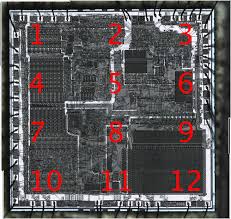 MCU Crack Security Solution
MCU Crack Security Solution
MCU Crack Security Solution was to place the EEPROM data storage chip next to the MCU inside the same plastic package. To attack such a MCU is not easy; a professional would decapsulate the sample and either microprobe the data or bond it into a separate test package.

Both methods require equipment which cannot be afforded by a low-budget MCU Cracker. Such an MCU Cracker could try to use homemade microprobers (bonding pads on old chips are relatively large) or exploit a software bug to get access to the data.
Some microcontrollers do not have any special microcontroller hardware security protection at all. Their protection is based on obscurity of the proprietary programming algorithm. It might be the case that the read-back function was deliberately disguised, or replaced with a verify-only function.
Usually such MCUs do not offer very good protection and some examples are presented. In fact, the verify-only approach could be very powerful if implemented properly, as it is in some smartcards.